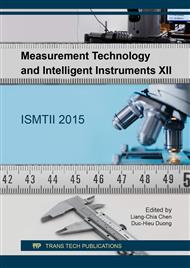p.179
p.185
p.191
p.197
p.203
p.209
p.215
p.223
p.231
Dynamic Calibration for Measurement System of Form Measuring Instruments Based on Elliptical Standard
Abstract:
A dynamic calibration method based on elliptical standard was put forward to further improve the calibration repeatability of measurement system of form measuring instruments. In this method, the radius difference of the major axis to the minor axis of elliptic contour acts as the standard value to calibrate the measuring system, and a low pass filter is used to filter the roughness, electrical noise and high frequency vibration signal which mixed into measurement data, the elliptic contour feature can be obtained accurately based on the low order harmonic properties. Compared with the traditional calibration method of flick standard, the proposed method ensure the calibration state is well consistent with the normal measuring state of the measuring system. Experimental results indicate that the calibration repeatability with 10nm can be achieved by measuring an elliptical standard. This method has been used in the calibration of measurement system of self-made ultra-precision cylindricity measuring instrument.
Info:
Periodical:
Pages:
203-208
Citation:
Online since:
September 2017
Authors:
Price:
Сopyright:
© 2017 Trans Tech Publications Ltd. All Rights Reserved
Share:
Citation:


